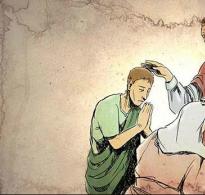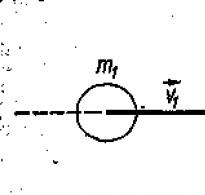How to make a spider with your own hands: diagrams for beginners. Volumetric animals from beads How to make a spider from beads for beginners
Few people associate spiders with pleasant moments. But in fact, this insect is a symbol of well-being and good luck. In the article you will learn how to make a spider from beads with a diagram and description. This is painstaking, but very entertaining work. Even beginners, using the instructions, will be able to make themselves a small talisman for good luck or as a gift to friends and family. You need to start with preparing the material. Carefully read the technology and choose the appropriate option for yourself.
Volumetric spider
One of the most common is the model of a fat spider-mascot. Weaving is quite simple and straightforward, suitable for beginners. The following materials will be required:
- a coil of wire with a diameter of 0.2 mm (approximately 130 cm);
- about 1 meter of thin fishing line;
- 5 grams of beads of different colors;
- needle.
But the main thing is to be patient and attentive. For clarity, a training video is provided at the end of the article. In the example, red and black beads No. 11 are used.

Weaving in stages
Three red beads are strung on a wire and placed exactly in the middle.

One end of the working thread (wire) is passed through two beads. The loop is carefully tightened.

The second end of the wire turned out to be a little longer. Four red beads are put on it. The loop is tightened again from the end of the same half of the wire. It is threaded through 2 middle beads.

Lightly tighten the resulting workpiece and bend it in the middle. The antennae of the future spider are ready!

To make the head, parallel weaving technology is used. Three red beads are strung on one of the wires, the second end is pulled through them in the opposite direction. The large loop is tightened. The next row is by bead color: black, red, black. These are the eyes of your masterpiece.
When tightening the wire, it is worth bending it a little and raising the arc to the top to add volume to the head.

By the way, the eyes can be made from larger beads, then the figure will turn out more interesting.
The next stage is similar to the previous one. Four red beads are strung on a wire, the other end is threaded and carefully tightened. But now the loop should go under the previous row. The spider's head is ready.

We move on to weaving insect legs using the needle technique. We string beads onto the end of the wire in the following sequence: 5H, 2K, 2H, 2K, 5H. I learned a row of 16 beads. We pass the end of the wire through 15 of them, leaving the first black one.

At the other end of the wire we perform the same operations. The “antennae” of the working thread remains near the head. We are switching to volumetric weaving again. Top row – 5 red, bottom row – 4 red.

We repeat all manipulations, starting from the first paw and ending with the bottom row. Half of our product is almost ready!
The third row of spider limbs is assembled in the following order: 3H, 2K, 2H, 2K, 3H for both legs.

Torso: top row -7K, bottom row - 5H.

We move on to the last longest row of paws. The sequence is: 5H, 2K, 2H, 2K, 2H, 2K, 2H, 5K.

All that remains is to finish the body of our spider. Using volumetric weaving technology, we continue to bend the rows, dividing them into the upper part (back) and lower part (abdomen). You must proceed according to the following scheme:
- Top row: 9H. Lower: 6H.
- Top row: 1H, 3K, 1H, 1K, 1H, 3K, 1H. Lower: 7H.
- Top row: 12H. Lower: 8H.
- Top row: 1H, 9K, 1H. Lower: 6H.
- Top row: 9H. Lower: 4H. Next we go to narrowing.
- Top row: 3K, 1H, 3K. Lower: 2H.

Last row: 3 black beads, which must be centered between the top and bottom beads.

We secure our structure and cut off the excess wire. The spider is ready!

But it turned out soft and doesn’t hold its shape at all. This can be corrected using prepared fishing line. We thread it through the coal eye and make 2 strong knots at the end. We push it under the last three beads and sew the beads in two rows in the center of the product.

First we go through the lower part, and then along the upper. We tighten the line well, make a knot, hiding it inside the spider. Your creation is now finished!

Product Variations
In many countries, it is believed that the red spider brings good luck. It is made from tubular, regular beads and beads. The diagram shows a six-fingered sample.

It must be woven from the end of the body, and the legs are attached to a separate wire in a circle. The result is a cute and exclusive spider.

Using solid, flexible wire, bright beads and stones you can make such a wonderful creation. The spider will decorate your home or become a nice gift.

Show your imagination, then create a real masterpiece with your own hands.
Video on the topic of the article
Spider signs that our ancestors believed in:
- a spider in the house - fortunately;
- kill a spider - bring misfortune, fire or ruin;
- a spider in the morning is a good fate;
- spider during the day - pleasant worries, good news;
- spider in the evening - you can expect a gift;
- seeing a spider in a dream means hope;
- red spider - for money and wealth, etc.















Well, how can you not want to have such happiness at home after this? It is not necessary to breed insects and hang cobwebs in the corners; you can simply make this “lovely” creation yourself. And perhaps a beaded spider will bring no less joy than its living prototype. Let's start with a little happiness.
In order to make a master class for beginners on the topic of bead weaving, we will need:
- beads of three colors (red, yellow, black);
- round nose pliers;
- wire;
- thread;
- one large and one small bead;
- transitional metal ring between beads (possible without it).
Master Class
- Prepare the necessary material and tools.

- Pass a piece of wire 10-15 cm long into the red bead and leave it in the middle. This will be the spout and the beginning of the weaving.

- Thread both ends of the wire through the smaller bead, then through the metal ring, through the larger bead, and back into the red bead.

- Cut the wire leaving 10mm. Now you need to use round pliers to make a narrow, neat ring out of this tip. The body is ready.

- We start weaving the paws from the point where the two beads join. Cut 4 pieces of wire 15-18 cm long, find the middle and twist it at this point 2 times.

- Separate the paws.

- To weave the legs, use red beads, alternating them on the knees with two yellow and one black beads, ending with a black and the same wire ring, twisted using pliers.

- When you finish weaving one side, move on to the second. The weaving pattern is exactly the same.

- The result is a small charming spider that brings good luck.

In order to make a master class on weaving this craft, we use a fairly detailed and understandable weaving pattern. Yellow, red and black beads are strung on a wire in a parallel manner, with even and odd rows being pulled together. Start weaving from the tail.

As a result, the bead spider turns out to be thick and voluminous. You can use your imagination with flowers while weaving; choose the length of the paws as you like.
To weave a bracelet with the image of a spider, you just need to remember the master class on weaving baubles and make a preliminary drawing. The weaving pattern should completely repeat the image. All you have to do is weave the fabric, and at the end weave several circular straps to decorate the bracelet.

This harmless predatory insect could be woven from beads if there was a pattern. But it is so complicated that no master class will help. Try to reconstruct the work order yourself from the photo.
I can only give a few tips:
- the handsome man's fluffy belly consists of many columns that are woven in the same way as the legs of a red spider made of wire and beads;
- for the legs, use three threads, on which three white columns of beads are strung in one direction and three again from the end of the leg in the opposite direction. A wire of 6 rows simply will not fit into yellow beads;
- weave the body from wire in a parallel way;
- end with antennae, twisting the ends of the wire into rings, like the spider that was above.

We will finish the master class by weaving the most promising insect. A red beaded spider in your home is a guarantee of good luck and prosperity. To make it, we will use two purple beads of different diameters and shapes, red and tubular dark beads.

The weaving pattern is given for a six-legged insect, but since we all know that spiders have 8 legs, it will not be difficult for us to weave another additional pair of limbs in the same way. We start weaving again from the tip of the tail.

May all these crafts bring happiness to your home.
In this master class we will show you how to make a spider from beads with your own hands. This stylish beaded spider makes a beautiful pendant, keychain or phone charm.
Tools and materials Time: 2 hours Difficulty: 4/10
- 1 faceted silver bead 12 mm for the body;
- 1 faceted black bead 10 mm for the head;
- 1 hairpin 5 cm;
- 4 faceted black beads;
- 68 black beads, size 11;
- 24 golden-colored bugles, size 1;
- 60 cm of black wire 20 gauge;
- round nose pliers;
- pliers;
- wire cutters.
A beaded spider as a pendant is an original and fashionable decoration if you like this style! This spider can also be used in themed compositions or used as decoration for Halloween!

Materials:

Step-by-step master class
So let's get started making this stylish beaded spider.
Step 1: Prepare the Base for the Body
Since our beaded spider consists of two main parts, you will first need to prepare the wire legs and body for the body.
Cut 4 pieces of wire 12.5 cm long.
Wrap the center portion of each piece of wire around a length of approximately 7-8 cm of hairpin, tightly. In this step you will need to make loops in the center of each piece of wire so that they can be threaded onto the spider's body.

Step 2: Assemble the Body Base
Assemble a structure of beads and wire according to the following scheme: one faceted silver bead 12 mm, four wires for the legs, one faceted black bead for the head.

Step 3: Make a Loop
Using pliers, make a simple loop over the 10mm bead. If this technology is new to you, watch the corresponding video on YouTube.
Tip: If you are using wire that might fray when pliers are used, use a permanent marker on the finish to hide any imperfections.

Clarification: the front and back legs of the spider should be slightly shorter than the four middle legs (to match natural proportions).
Step 4: Add Beads to the Front Foot
Add beads to the front wire according to the following pattern: 2 black beads, 1 golden bugle, 2 beads, 1 bugle, 2 beads, 1 bugle, 2 beads.

Step 5: Make a Loop
From the last bead, cut off the protruding end of the wire, leaving a piece of approximately 6-7 mm. Using pliers, wrap this piece into a loop and secure all the beads in place. Insert the end of the loop into the last bead.

Step 6: Repeat steps
Add beads and form loops on all four front and back legs.

Step 7: Add Beads to the Middle Foot
Add beads to one of the middle legs according to the following pattern: 2 beads, 1 bugle bead, 1 bead, 1 faceted bead 3 mm, 1 bead, 1 bugle bead, 2 black beads, 1 bugle bead, 2 beads.
In the same way as in step 5, cut off the protruding end of the wire from the last bead, leaving a piece of approximately 6-7 mm. Next, wrap the wire into a loop using pliers and secure all the beads in place. Insert the end of the loop into the last bead.
Step 8: Add Beads to All Middle Paws
Repeat step 7 for all four middle legs.

A wide variety of different bugs and spiders made of beads and beads. Almost all of them are woven using a parallel weaving technique on wire.

There are both simple and complex types of products. Try to weave according to the pattern and you will succeed.


Spiders made of beads and bugles
Required:large round bead with a diameter of 10 mm, a small bead with a diameter of 5 mm, 16 tubes of bugles 15 mm long, 17 red beads, 2 blue beads, 75 cm of wire.

String the red bead onto the wire and fold the wire so that one end is 5 cm longer than the other. String a large bead onto both ends of the wire (Fig. 1, a). On one end, string a tube of bugles, a red bead, a tube of bugles, a red bead. Thread the wire in the opposite direction through the glass bead, bead, glass bead. Push everything towards a large bead and pull the wire - you get a leg (Fig. 1, b). At the same end of the wire, make 3 more legs, placing them next to each other (Fig. 1, c). At the second end of the wire, make the same 4 legs.

Place the end of the wire under the base of the leg, the first at this end (Fig. 1, d). Stretch the wire, gathering all 4 legs into a bun. Gather your legs into a bun at the other end (Fig. 1, e). String a small bead on both ends. Then string a blue bead onto each end of the wire. Pass the short end of the wire through the bead on the long end (toward it) and through both beads (Fig. 1, e). Pull the wire.
Take the spider by the head and the rear end, twist it 5-7 times, holding both ends of the wire. Cut off the end at the back. Straighten the spider's legs and hang it by the remaining end of the wire, which looks like a cobweb (Fig. 1, g).
Marina Lyaukina
Spider signs that our ancestors believed in:
- a spider in the house - fortunately;
- kill a spider - bring misfortune, fire or ruin;
- a spider in the morning is a good fate;
- spider during the day - pleasant worries, good news;
- spider in the evening - you can expect a gift;
- seeing a spider in a dream means hope;
- red spider - for money and wealth, etc.
Well, how can you not want to have such happiness at home after this? It is not necessary to breed insects and hang cobwebs in the corners; you can simply make this “lovely” creation yourself. And perhaps a beaded spider will bring no less joy than its living prototype. Let's start with a little happiness.
Spider
In order to make a master class for beginners on the topic of bead weaving, we will need:
- beads of three colors (red, yellow, black);
- round nose pliers;
- wire;
- thread;
- one large and one small bead;
- transitional metal ring between beads (possible without it).
Master Class
- Prepare the necessary material and tools.
- Pass a piece of wire 10-15 cm long into the red bead and leave it in the middle. This will be the spout and the beginning of the weaving.

- Thread both ends of the wire through the smaller bead, then through the metal ring, through the larger bead, and back into the red bead.

- Cut the wire leaving 10mm. Now you need to use round pliers to make a narrow, neat ring out of this tip. The body is ready.

- We start weaving the paws from the point where the two beads join. Cut 4 pieces of wire 15-18 cm long, find the middle and twist it at this point 2 times.

- Separate the paws.

- To weave the legs, use red beads, alternating them on the knees with two yellow and one black beads, ending with a black and the same wire ring, twisted using pliers.

- When you finish weaving one side, move on to the second. The weaving pattern is exactly the same.

- The result is a small charming spider that brings good luck.

Fat spider
In order to make a master class on weaving this craft, we use a fairly detailed and understandable weaving pattern. Yellow, red and black beads are strung on a wire in a parallel manner, with even and odd rows being pulled together. Start weaving from the tail.

As a result, the bead spider turns out to be thick and voluminous. You can use your imagination with flowers while weaving; choose the length of the paws as you like.

Bracelet
To weave a bracelet with the image of a spider, you just need to remember the master class on weaving baubles and make a preliminary drawing. The weaving pattern should completely repeat the image. All you have to do is weave the fabric, and at the end weave several circular straps to decorate the bracelet.

Tarantula
This harmless predatory insect could be woven from beads if there was a pattern. But it is so complicated that no master class will help. Try to reconstruct the work order yourself from the photo.
I can only give a few tips:
- the handsome man's fluffy belly consists of many columns that are woven in the same way as the legs of a red spider made of wire and beads;
- for the legs, use three threads, on which three white columns of beads are strung in one direction and three again from the end of the leg in the opposite direction. A wire of 6 rows simply will not fit into yellow beads;
- weave the body from wire in a parallel way;
- end with antennae, twisting the ends of the wire into rings, like the spider that was above.

Red spider
We will finish the master class by weaving the most promising insect. A red beaded spider in your home is a guarantee of good luck and prosperity. To make it, we will use two purple beads of different diameters and shapes, red and tubular dark beads.

The weaving pattern is given for a six-legged insect, but since we all know that spiders have 8 legs, it will not be difficult for us to weave another additional pair of limbs in the same way. We start weaving again from the tip of the tail.

May all these crafts bring happiness to your home.






